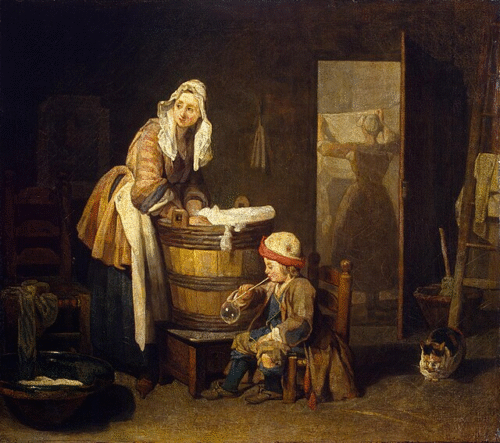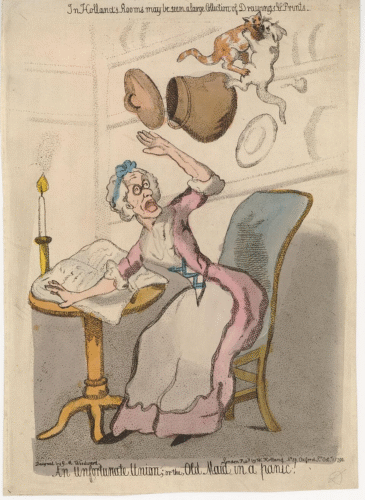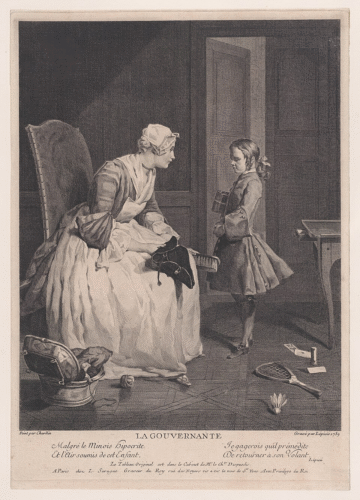Financial Realities for Regency Women

In the series: Everything is to be Got with Money ,we’ve been examining the money and incomes in the Regency era. So far, we’ve been talking about the gentlemen, but what about the women?
Working and lower middle-class women
In the working and lower-middle classes, girls could start working young. There was no shame in it, and marriage didn’t mean the end of work, as it did for the upper social classes. A woman might hope to marry a man who could support her, but it was perfectly acceptable, and often necessary, for her to earn her own income. However, once she married, her income legally belonged to her husband, and she had no real rights to it.

Jobs a Regency era woman might hold included: seamstress, millinery and similar work, laundress/washer-woman/char-woman, barmaid, house servant or maid, and factory work. Some women even ran their own small businesses, like laundries or bakeries. While these jobs didn’t hurt a woman’s marriage chances, and in some cases might improve them since they would add to a household’s income, they often paid very little and involved long, difficult hours.
Housemaids and nursery maids (lower servants) might earn £5–£15/year, depending on skill and position (plus room and board). Housekeepers and head nurses (upper servants) could earn £20–£25/year (plus room and board). Male servants nearly always earned more than female ones serving in comparable-level roles.
Seamstresses might learn £1/week, depending on skill, but they worked very long hours, and often with very poor lighting. A factory worker might earn £0.10–£0.30/day. For the most part, more skilled positions were rarely open to women as they lacked access to the training that would fit them for such opportunities. Occasionally, if a parent, usually her father, had a skilled trade, for example silver or gold smithing, a daughter might be trained in the family business. But this was more the exception than the rule.
Middle- and Upper-Class Women
Women from higher social classes had even fewer opportunities than women from lower classes. Their only respectable option was to marry. As far as employment went, upper-class ladies had limited job prospects, given their desire to remain respectable—and their more or less complete lack of marketable skills. Ladies from “better” families were raised to be refined, charming, and well-educated in things like music, languages, and household management—perfect training for being a good wife. If that didn’t happen, the training could be applied to one of the genteel female options: a lady’s companion or a governess.
Spinsters

The plight of Regency spinsters is fairly well documented. The local tax and judicial records sum it up well. Women were typically identified in tax or judicial records by their marital status (spinsters, wives and widows) whereas men were always identified by their occupation or social status. (Shoemaker, 1998) The message was clear: a woman’s identity (and legal existence) was determined by her marital status. Still though, after the losses of the Napoleonic war, nearly a quarter of women in the upper classes never found husbands.
That status though, was not morally neutral. Spinsterhood was considered ‘unnatural’ for a woman (Day, 2006). They were called ‘ape-leaders’ (for that was what they would be doing in hell as punishment for the unnatural lifestyle. Enough said on that point….) and ridiculed for their failure in the most basic requirements of femininity.
Some spinsters had money—and that changed everything. Others would have to find some means to shift for themselves.
Ladies of Independent Means
However, if a single woman possessed independent means—a fortune of her own, often in the form of an inheritance or dowry, sufficient for her to live on, it was possible she could maintain her own household and carry on an independent life. Female investors were not unknown, and their capital supported the joint stock companies behind municipal utilities and railways. (Not going to comment on the irony here–good enough to provide money, but not enough to be respected in society…) Wise investments could provide a steady income without administrative worries. (Davidoff & Hall, 2002)
Of course, money didn’t guarantee freedom. Brothers, fathers, and uncles often controlled women’s finances “for their own good,” making it difficult or impossible for her to access her own fortune. (Naturally, the men in her life knew better how to manage her affairs than she did .) That meant even wealthy spinsters might need permission to spend their own cash.
Relatively few spinsters had independent means, though. In those cases, a she would have two choices: find a job to support herself or live in the house of a relative. If she lived in the house of a relative, she would be expected to earn her keep, not sponge off the family willing to endure her presence. One option might be keeping house for bachelor (or widowed) brothers or uncles. It that was not an option, she might cook, clean, care for children, the elderly or infirm, cover for married sisters while they were indisposed or during lying-in, or whatever else deemed necessary by the mistress of the family. And she would always, always have sewing in her hand, mending and making goods and clothes for the household. Even if she did all this, she would still be considered more or less a parasite on good society.
Governess

The Governess, print, Bernard Lepicié, after Jean Siméon Chardin 1739, public domain
A governess was like a private tutor. She lived with a family and taught their children reading, writing, math, and French—plus music, manners, and morals. This job required education, good manners, and the ability to keep children in line, but the pay was low.
Within the households they served, they existed in a nether realm, not equal to the family but above the servants. Often, a governess would associate with neither, virtually shut away from all society. In smaller households, she might be expected to help with chores after the children went to bed. She would also be vulnerable, as all female servants were, to (unwanted) advances from the males of the household.
Governess wages ranged from £12–£30 a year (plus food and lodging) though some made as much as £100 in rare cases, particularly in remote households and noble families. That sounds okay—until you remember she worked 12-hour days, six or seven days a week, with possibly a half day off a week.
Finding work as a governess wasn’t easy. Women often got recommended by a family friend. If that was not an option, she might answer newspaper ads from families seeking help, place their own ads offering services and references, or register with governess agencies, like Mrs. Burne’s in London.
Religion could also matter. Some families only wanted Anglican (Church of England) governesses, and others wanted Catholic or Protestant tutors based on their own beliefs.
Companion
A companion’s job was to be nice. Seriously. She kept an older lady company, helped write letters, played cards, read books aloud, and made sure nobody got too lonely. Usually a companion was an older, unmarried or widowed woman. She was required to be agreeable, well-spoken, and flexible. In some cases, she might help manage a small household or go traveling with her employer to places like Bath or Scarborough.

This could be a paid job with wages similar to a governess at £15–£30/year—or justa room and board situation.
These positions were often advertised in newspapers, and many women who applied for governess work also offered themselves as companions. Family members sometimes filled the role for free, especially if the potential companion had nowhere else to go.
While some companions got lucky and traveled with their employers to fun places like Bath or Brighton, she was not expected to have her own social life any more than a governess was. So the change of venue might mean little more than a different house to her.
For all their limitations, positions as governesses and companions offered a way for respectable women to stay connected to their social class. They could still attend church, read novels, or walk in the park. And who knew—a visiting gentleman might notice them.
But there were also risks in such notice. Any stain to her reputation would likely end her employment, so governesses and companions had to guard against anything that might jeopardize their already fragile positions.
References
Baird, Rosemary. Mistress of the House: Great Ladies and Grand Houses, 1670-1830. London: Phoenix, 2004.
Collins, Irene. Jane Austen, the Parson’s Daughter. London: Hambledon Press, 1998.
Davidoff, Leonore, and Catherine Hall. Family Fortunes: Men and Women of the English Middle Class, 1780-1850. Chicago: University of Chicago Press, 1987.
Day, Malcom. Voices from the World of Jane Austen. David&Charles, 2006.
Jones, Hazel. Jane Austen and Marriage. London: Continuum, 2009.
Hart, Stephen. Wages. Website of Pascal Bonenfant. Accessed July 2, 2025. https://www.pascalbonenfant.com/18c/wages.html
Heather. Reading the Regency: Acceptable Occupations of Ladies. Wattpad. August 3, 2020. Accessed July 2. 2025. https://www.wattpad.com/930907882-reading-the-regency-acceptable-occupations-for/
Horn, Pamela. Flunkeys and scullions: life below stairs in Georgian England. Stroud: Sutton, 2004.
Laudermilk, Sharon H., and Teresa L. Hamlin. The Regency Companion. New York: Garland, 1989.
Martin, Joanna. Wives and Daughters: Women and Children in the Georgian Country House. London: Hambledon and London, 2004.
Shoemaker, Robert Brink. Gender in English Society, 1650-1850: The Emergence of Separate Spheres? London: Longman, 1998. Pearson Education Limited
The Woman’s advocate or The baudy batchelor out in his calculation: Being the genuine answer paragraph by paragraph, to the batchelor’s estimate plainly proving that marriage is to a man of sense and oeconomy, both a happier and less changeable state, than a single life. Written for the honour of the good wives, and pretty girls of old England. London: Printed for A. Moore, near St. Paul’s, 1729.
Vickery, Amanda. Behind Closed Doors: At Home in Georgian England. New Haven, Conn.: Yale University Press, 2009.
Vickery, Amanda. The Gentleman’s Daughter: Women’s Lives in Georgian England. New Haven, Conn.: Yale University Press, 1998.

Comments
Financial Realities for Regency Women — No Comments
HTML tags allowed in your comment: <a href="" title=""> <abbr title=""> <acronym title=""> <b> <blockquote cite=""> <cite> <code> <del datetime=""> <em> <i> <q cite=""> <s> <strike> <strong>